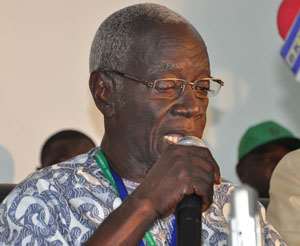
On Wednesday, Phillip Addison and Dr. Kwadwo Afari-Gyan found a formula that untangles the mystery surrounding entries on the Statement of Poll and Declaration of Results for the office of President (Pink Sheet).
The new formula derived by Mr. Phillip Addison, the lead attorney for the petitioners challenging the results of the last presidential elections, and consented to by Dr. Afari-Gyan, the chairman of the Electoral Commission, explains entries on 30 pink sheets reviewed by the witness in court. Dr. Kwadwo Afari-Gyan is undergoing cross-examination by Phillip Addison.
'Dr. Afari-Gyan, I am suggesting to you that C6=A1. If instead of C3, you add C5 and drop C3 or replace C3 with C5 then A1=C6,' said Phillip Addison in explaining the pink sheets.
'My Lords, I agree,' said Dr. Afari-Gyan.
Mr. Addison then continued with more sample pink sheets and the witness agreed in each instance.
On the face of the pink sheets, section A asks for ballot information and has a requirement that it must be filled out before voting starts at the polling station. Section C talks about ballot accounting and has a requirement that it must be filled out at the close of voting before counting begins.
The strict timing requirements imposed on the sections of the pink sheets test the sanctity of the entries and lack of agreement among the entries throws away the authenticity of the votes recorded on the pink sheets.
At the beginning of the polls, the presiding officer fills in question A1, the number of ballots issued to the polling station. At the close of balloting, before counting commences, the presiding officer fills in C6, sum of C1, C2, C3 and C4.
C1 is the total number of voters on the polling station register. C2 is the total number of ballots on the proxy list. C3 is the total number of voters who were not verified by the biometric device. C4 is the total number of spoilt ballots. C5 is the number of unused ballots.
Based on the new formula derived by Phillip Addison and agreed to by Dr. Afari-Gyan, the number of ballots issued at the beginning of polling must be accounted for at end of polling, a sort of balancing a ballot account.
Now, the sum of C1, C2, C4 and C5 is C6 and C6 is equal to A1. This new formula balances the ballots at the beginning of polls to the ballots at the end of polling.
Examples:
At polling station Code A023101: A1=550 and C6=550; the entry in C3 is 92, but dropped.
At polling station Code K090701: A1=475 and C6=475;
At polling station Code G190901: A1=650 and C6=650
Mr. Phillip Addison also suggested to Dr. Afari-Gyan that the Electoral Commission made a typographical error by stating C6 on the pink sheets as the sum of C1, C2, C3 and C4 instead of the correct addition which is C1, C2, C4 and C5. Dr. Afari-Gyan agreed.
'My Lords, I think that is correct,' Dr. Afari-Gyan said.
Editor's Note:Kofi Amoabin, DePaul University Graduate School of Communications, Chicago




 Critics fear Togo reforms leave little room for change in election
Critics fear Togo reforms leave little room for change in election
 Flooding: Obey weather warnings – NADMO to general public
Flooding: Obey weather warnings – NADMO to general public
 Fire in NDC over boycott of Ejisu by-election
Fire in NDC over boycott of Ejisu by-election
 NDC to outdoor Prof Jane Naana Opoku-Agyemang as running mate today
NDC to outdoor Prof Jane Naana Opoku-Agyemang as running mate today
 Ejisu: CPP seeks injunction to stop April 30 by-election
Ejisu: CPP seeks injunction to stop April 30 by-election
 Dismiss ECG, GWCL, GACL bosses over losses – United Voices for Change tells gov’...
Dismiss ECG, GWCL, GACL bosses over losses – United Voices for Change tells gov’...
 Submit 2023 audited financial statements by May – Akufo-Addo order SOEs
Submit 2023 audited financial statements by May – Akufo-Addo order SOEs
 Current power outages purely due to mismanagement – Minority
Current power outages purely due to mismanagement – Minority
 ECG hoists red flag to fight Ashanti Regional Minister over arrest of General Ma...
ECG hoists red flag to fight Ashanti Regional Minister over arrest of General Ma...
 Mahama’s 24hr economy will help stabilise the cedi; it’s the best sellable polic...
Mahama’s 24hr economy will help stabilise the cedi; it’s the best sellable polic...
